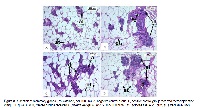Antifertility properties of Cissamplelos pareira Linn. leaf gel in male and female mice
Keywords:
Cissampelos pareira Linn., antifertility, prolactin, testosterone, fertility indexAbstract
This study aimed to evaluate the antifertility properties of C. pareira Linn. leaf gel in male mice by evaluation of blood prolactin, testosterone and seminal quality. In females mice, estrous index, fertility index and prolactin level were determined. The results for males revealed that the leaf gel at a dose of 30 mg/100 gBW significantly increased blood prolactin, while the leaf gel at 20 and 30 mg/100 gBW decreased testosterone levels in a dose dependent manner (P<0.05). Interestingly, all doses (10, 20 and 30 mg/100 gBW) of leaf gel caused significant impairement of sperm quality collected from epididymis and vas deferens after 21 days of oral adminitration. The results for females showed that the leaf gel at 40 and 60 mg/100 gBW caused irregular estrous cycle and inhibited ovulation by decrease in estrous index during the 21 days of treatment. Meanwhile, it also revealed significant increases in blood prolactin and decreased embryo implantation in pregnant mice after 10 days of treatment. It may be concluded that C. pareira leaf gel has antifertility properties in male by disturbance of blood prolactin and testosterone levels, consequently affecting spermatogenesis and impaired sperm quality. Meanwhile, it inhibits ovulation in females and inhibits embryo implantation or decreases fertility index by increasing prolactin in pregnant mice. Therefore, the use of C. pareira leaf gel as food or for therapy in traditional medicines should be avoided because of this adverse effect.
References
Manu A, Tanvi S, Anu D, Neeraj B & Ahmad SA, An inside reviewof Cissampelos
pareira Linn.: A potential of medicinal plant of India, Inter Res J Pharm, 2012, 3: 38-41.
Smitinand T & Larsen K, Flora of Thailand Vol. 5 Part 3. The Forest Herbarium Royal,
Forest Department, Bangkok, 1991.
Singh A, Duggal S, Singh J & Katekhaye S, An inside preview of ethnopharmacology of
Cissampelos pareira Linn., Inter J Biol Tech, 2010, 1: 114-120.
Singthong J, Cui SW, Ningsanond S & Goff HD, Structural characterization degree of
esterification and some gelling properties of Krueo Ma Noy (Cissampelos pareira)
pectin, Carbohyd Polym, 2004, 59: 391-400.
Mokkasamit M, Ngarmwathana W, Sawasdimongkol K & Permphiphat U,
Pharmacological evaluation of Thai medicinal plants, J Med Ass Thailand, 1971, 54: 490-
Dandiya PC & Chopra YM, CNS-active drugs from plants indigenous to India. Indian J
Pharma. 1970, 2: 67–90.
Amresh G, Rao V, Mehrotra S & Shirwaiker A, Standardization and ethnopharmacological
evaluation of antidiarrhoeal herbal formulation Manipal Academy of Higher Education ,
Manipal (Dissertation), Karnataka, India, pp: 24, 2003.
Maurya R, Srivastava S, Kulshreshta DK & Gupta CM, Traditional remedies for fertility
regulation, Curr Med Chem, 2004, 11: 1431-1450.
Ganguly M, Borthakur M, Devi N & Mahanta R, Antifertility activity of methanolic leaf
extract of Cissampelos pareira in female albino mice, J Ethnopharmacol, 2007, 111: 688-
Harisha B, Antifertility effect of hydro-alcoholic extract of Cissampelos pareira Linn.
on male albino rats, Int J Pharml Res& Dev, 2012, 3: 87-93.
Luangpirom A, Sirisan W & Pontaisong J, Antifertility activity of the aqueous leaf
extract of Cissampelos pareira in male albino mice, ABAH bioflux, 2010, 2: 59-64.
Cooper RL, Goldman JM & Vandenbergh JG, Mornitoring of the estrous cycle in the
laboratory rodent by vaginal lavage. In method of toxicology in female reproductive
toxicology. JJ Heindel and RE Chapin (Eds) Vol 3 pp57-58, San Diego, Academic press,
USA, 2010, 189-248.
Baligar PN & Kaliwal BB, Induction of gonadal toxicity to female rats after chronic
exposure to mancozeb, IND Health, 2001, 39: 235-243.
Masson JM, & Kang YJ, Test method for assessing female reproductive and
developmental Toxicology, In principle and method of toxicology. Hayes, Raven Press.
New York, 1994.
Zar JH, Biostatistical analysis. 5th edition, Pearson Prentice Hall, Inc. New Jersey, USA,
, 189-248.
Freeman ME, Kanyicska B, Lerant A & Nagy G, Prolactin: structure, function, and
regulation of secretion, Physiol Rev, 2000, 80: 1523-1528..
De Rosa M, Zarrilli S, Di Sarno A, Milano N, Gacione M, Boggia B, Lombardi G &
Colao A, Hyperprolactinemia in men, Endocrine, 2003, 20: 75.-82.
McCallum RW, Sowers JR, Hershman JM & Sturdevant RA, Metoclopramide stimulates prolactin secretion in man, J Clin Endocrineol Metab, 1976, 42: 1148-1152.
Masud S, Mehboob F & Bappi MU, Severe hyperprolactinemia directly depresses the
gonadal activity causing infertility, Esculapio, 2007, 2: 25-27.
Jones RE, Hormonal control of sex accessory structure: In Human Reproductive
Biology, 2nd edition, Academic press, New York. USA, 107-109.
Chandra AK, Sengupta P, Goswami H & Sarkar M, Excessive dietary calcium in the
disruption of structural and functional status of adult male reproductive system in rat with
possible mechanism, Mol Cell Biochem, 2012, 364: 181-191.
Chandra AK, Sengupta P, Goswami H & Sarkar M, Effect of dietary magnesium on
testicular histology, steroidogenesis, spermatogenesis and oxidative marker in adult rats,
Indian J Exper Biol, 2012, 51: 37-47.
.Sorensen AMJ, Animal reproduction: principles and practice, Graw-Hill, USA, 1979.
Sharma RK, Goyal AK & Bhat RA, Antifertility of plant extracts on female
reproduction: A review, Int J Pharm Bio Sci, 2013, 3: 493-514.



